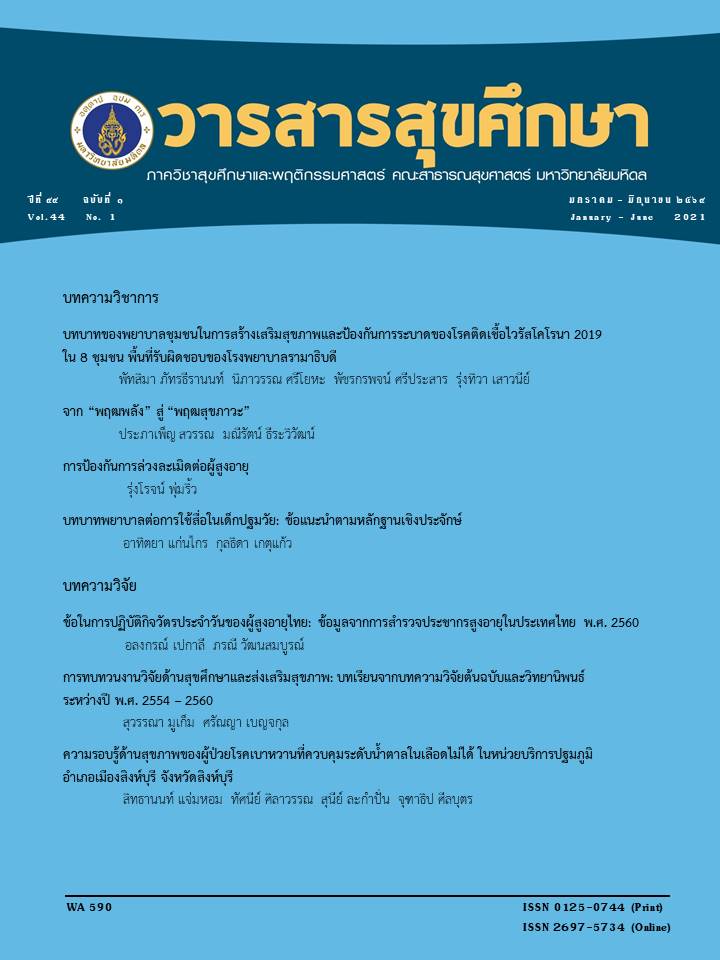The Limited Activities of Daily Living (ADLs) among Thai Older Adults: An evidence from the 2017 national survey of older persons in Thailand
Main Article Content
Abstract
Ability to accomplish activities of daily living (ADLs)- routine activities people do every day without assistance, among older adults is important to determine the needs of aids and assistants, and quality of life improvement. This secondary research aimed to assess the limited ADL among older adults and its associated factors. The data of the 2017 survey of the older persons in Thailand permitted by the National Statistical Office were used for the study. The sample of 39,032 older adults aged 60 years and over who reported on their activities of daily living were selected to analyze. Descriptive statistics and binary logistic regression analysis were employed for data analysis.
The results showed as overall that 29.4 % of older adults reported at least one limited ADL. Among the 10 basic ADLs, incontinence (17.4 %) and mobility within their house (16.4 %) were mostly reported as limited activities. The result of binary logistic regression analysis revealed that the factors significantly associated with having at least one limited ADLs were being female; mid-old and oldest-old persons; single/widowed/divorced/ separated status; completing education at below bachelor’s degree; insufficient income; having fall history; having visual, hearing, and chewing problems; and no regular exercise. The findings suggest the related agencies such as the Division of Health, Ministry of Public Health, and Department of Older Persons, Ministry of Social Development and Human Security for provisions of elderly care and support, particularly for older adults with low socioeconomic status. Screening of degenerative and functional problems should be implemented as routine annual health check-ups to early detect and plan to support and care.
Article Details
References
สถาบันวิจัยประชากรและสังคม. มิเตอร์ประเทศไทย 2564 [เข้าถึงเมื่อ 19 มีนาคม 2564]. เข้าถึงได้จาก: http://www.thailandometers.mahidol.ac.th/.
Population Projection Working Group. Population Projections for Thailand: 2010–2040. 2013.
World Bank. Thailand Life Expectancy 2021 [cited 2021 March 19]. Available from: https://data.worldbank.org/indicator/SP.DYN.LE00.IN?locations=TH.
คณะทำงานสุขภาพคนไทย. สุขภาพคนไทย 2560. กรุงเทพฯ: อมรินทร์พริ้นติ้ง แอนด์พับลิชชิ่ง; 2560.
คณะทำงานสุขภาพคนไทย. สุขภาพคนไทย 2561. กรุงเทพฯ: อมรินทร์พริ้นติ้ง แอนด์พับลิชชิ่ง; 2561.
คณะทำงานสุขภาพคนไทย. สุขภาพคนไทย 2562. กรุงเทพฯ: อมรินทร์พริ้นติ้ง แอนด์พับลิชชิ่ง; 2562.
Foundation of Thai Gerontology Research and Development Institute. Situation of the Thai elderly 2011. 2012.
Edemekong PF, Bomgaars DL, Sukumaran S, Levy SB. Activities of Daily Living. StatPearls. Treasure Island (FL): StatPearls Publishing; 2021.
World Health Organization. Disability and Health: Geneva; 2020 [cited 2021 March 19]. Available from: https://www.who.int/news-room/fact-sheets/detail/disability-and-health.
รุ่งโรจน์ พุ่มริ้ว. ผู้สูงอายุ ปัญหา และนวัตกรรมผลิตภัณฑ์สำหรับผู้สูงอายุ. วารสารสุขศึกษา. 2561;41(2):9.
สำนักอนามัยผู้สูงอายุ กรมอนามัย กระทรวงสาธารณสุข. คู่มือมาตรฐานบริการส่งเสริมสุขภาพผู้สูงอายุ. สำนักบริการวิชาการ มหาวิทยาลัยศิลปากร; 2561. 128 หน้า.
Verropoulou G, Tsimbos C. Disability trends among older adults in ten European countries over 2004-2013, using various indicators and Survey of Health, Ageing and Retirement in Europe (SHARE) data. Ageing and Society. 2017;37(10):2152.
Connolly D, Garvey J, McKee G. Factors associated with ADL/IADL disability in community dwelling older adults in the Irish longitudinal study on ageing (TILDA). Disability and rehabilitation. 2017;39(8):809-16.
Ćwirlej-Sozanska A, Wisniowska-Szurlej A, Wilmowska-Pietruszynska A, Sozanski B. Determinants of ADL and IADL disability in older adults in southeastern Poland. BMC geriatrics. 2019;19(1):1-13.
Taş Ü, Verhagen AP, Bierma-Zeinstra SM, Hofman A, Odding E, Pols HA, et al. Incidence and risk factors of disability in the elderly: the Rotterdam Study. Preventive medicine. 2007;44(3):272-8.
Feng Z, Lugtenberg M, Franse C, Fang X, Hu S, Jin C, et al. Risk factors and protective factors associated with incident or increase of frailty among community-dwelling older adults: A systematic review of longitudinal studies. PloS one. 2017;12(6):e0178383.
แจ่มจันทร์ ประทีปมโนวงศ์. ความสัมพันธ์ระหว่างความสามารถในการปฏิบัติกิจวัตรประจำวันพฤติกรรมการออกกำลังกาย และคุณภาพชีวิตผู้สูงอายุโรคหลอดเลือดหัวใจ. วารสารคณะพยาบาลศาสตร์ มหาวิทยาลัยบูรพา. 2019;27(4):66-76.
Supurairat C, Jai-aree A. Factors related to the ability to perform daily activities of the elderly intambon huaykwang, ampeo kamphaeng saen, changwat nakhonpathom. Veridian E-Journal, Silpakorn University (Humanities, Social Sciences and arts). 2014;7(2):187-202.
สำนักงานสถิติแห่งชาติ. รายงานการสำรวจประชากรสูงอายุประเทศไทย พ.ศ. 2560. 2561.
Ferrucci L, Koh C, Bandinelli S, Guralnik J. Disability, functional status, and activities of daily living. Encyclopedia of gerontology: Elsevier Inc.; 2010. p. 427-36.
Hung WW, Ross JS, Boockvar KS, Siu AL. Recent trends in chronic disease, impairment and disability among older adults in the United States. BMC geriatrics. 2011;11(1):1-12.
Jiravaranun S, Jaipang C. Urinary incontinence in older people: Nursing Role. Vajira Nursing Journal. 2019;21(2):77-87.
Peron EP, Gray SL, Hanlon JT. Medication use and functional status decline in older adults: a narrative review. The American journal of geriatric pharmacotherapy. 2011;9(6):378-91.


